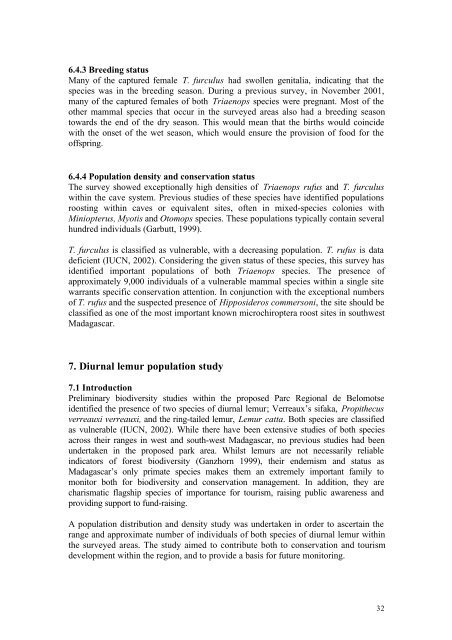The proposed Parc Regional de Belomotse - Frontier-publications ...
The proposed Parc Regional de Belomotse - Frontier-publications ...
The proposed Parc Regional de Belomotse - Frontier-publications ...
Create successful ePaper yourself
Turn your PDF publications into a flip-book with our unique Google optimized e-Paper software.
6.4.3 Breeding status<br />
Many of the captured female T. furculus had swollen genitalia, indicating that the<br />
species was in the breeding season. During a previous survey, in November 2001,<br />
many of the captured females of both Triaenops species were pregnant. Most of the<br />
other mammal species that occur in the surveyed areas also had a breeding season<br />
towards the end of the dry season. This would mean that the births would coinci<strong>de</strong><br />
with the onset of the wet season, which would ensure the provision of food for the<br />
offspring.<br />
6.4.4 Population <strong>de</strong>nsity and conservation status<br />
<strong>The</strong> survey showed exceptionally high <strong>de</strong>nsities of Triaenops rufus and T. furculus<br />
within the cave system. Previous studies of these species have i<strong>de</strong>ntified populations<br />
roosting within caves or equivalent sites, often in mixed-species colonies with<br />
Miniopterus, Myotis and Otomops species. <strong>The</strong>se populations typically contain several<br />
hundred individuals (Garbutt, 1999).<br />
T. furculus is classified as vulnerable, with a <strong>de</strong>creasing population. T. rufus is data<br />
<strong>de</strong>ficient (IUCN, 2002). Consi<strong>de</strong>ring the given status of these species, this survey has<br />
i<strong>de</strong>ntified important populations of both Triaenops species. <strong>The</strong> presence of<br />
approximately 9,000 individuals of a vulnerable mammal species within a single site<br />
warrants specific conservation attention. In conjunction with the exceptional numbers<br />
of T. rufus and the suspected presence of Hipposi<strong>de</strong>ros commersoni, the site should be<br />
classified as one of the most important known microchiroptera roost sites in southwest<br />
Madagascar.<br />
7. Diurnal lemur population study<br />
7.1 Introduction<br />
Preliminary biodiversity studies within the <strong>proposed</strong> <strong>Parc</strong> <strong>Regional</strong> <strong>de</strong> <strong>Belomotse</strong><br />
i<strong>de</strong>ntified the presence of two species of diurnal lemur; Verreaux’s sifaka, Propithecus<br />
verreauxi verreauxi, and the ring-tailed lemur, Lemur catta. Both species are classified<br />
as vulnerable (IUCN, 2002). While there have been extensive studies of both species<br />
across their ranges in west and south-west Madagascar, no previous studies had been<br />
un<strong>de</strong>rtaken in the <strong>proposed</strong> park area. Whilst lemurs are not necessarily reliable<br />
indicators of forest biodiversity (Ganzhorn 1999), their en<strong>de</strong>mism and status as<br />
Madagascar’s only primate species makes them an extremely important family to<br />
monitor both for biodiversity and conservation management. In addition, they are<br />
charismatic flagship species of importance for tourism, raising public awareness and<br />
providing support to fund-raising.<br />
A population distribution and <strong>de</strong>nsity study was un<strong>de</strong>rtaken in or<strong>de</strong>r to ascertain the<br />
range and approximate number of individuals of both species of diurnal lemur within<br />
the surveyed areas. <strong>The</strong> study aimed to contribute both to conservation and tourism<br />
<strong>de</strong>velopment within the region, and to provi<strong>de</strong> a basis for future monitoring.<br />
32
















